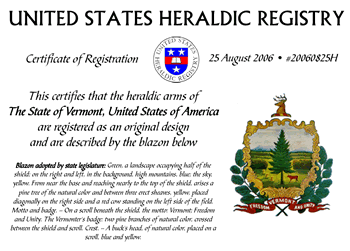U.S. Heraldic Registry
Registration of contemporary and historical American heraldry
The State of Vermont, United States of America
Registration number 20060825J
This certifies that the heraldic arms of The State of Vermont, United States of America are registered as an original design and are described by the blazon below

Sources
The historical note is quoted from FOTW Flags Of The World website at URL http://flagspot.net/flags/. Original author is Joe McMillan.
Image from Vermont state libraries website at URL http://dol.state.vt.us/
Historical note
The Vermont coat of arms was officially described by Act No. 11 of 1862 (codified as Title 1, Vermont Statutes Annotated, Sec. 491): "Coat of arms. -- Green, a landscape occupying half of the shield; on the right and left, in the background, high mountains, blue; the sky, yellow. From near the base and reaching nearly to the top of the shield, arises a pine tree of the natural color and between three erect sheaves, yellow, placed diagonally on the right side and a red cow standing on the left side of the field. Motto and badge. -- On a scroll beneath the shield, the motto: Vermont; Freedom and Unity. The Vermonter's badge: two pine branches of natural color, crossed between the shield and scroll. Crest. -- A buck's head, of natural color, placed on a scroll, blue and yellow."
According to a 1939 study entitled "The Coat of Arms and Great Seal of Vermont," by John P. Clement, this coat of arms first appeared in 1821 as an engraving on state military commissions. The design was based on the graphic elements in the state seal that had been adopted on February 20, 1779, but which is a much more abstract design. The buck's head crest may have been devised by the then-secretary of state, Robert Temple, or the engraver who designed the commission form. The design continued in de facto use as the state coat of arms until the time of the Civil War. This included being shown on state publications and in a carving over the speaker's desk in the state House of Representatives. The crossed pine branches first appeared on the title page of the 1840 edition of the state's Revised Statutes; they are a reference to pine sprigs worn by Vermont troops at the Battle of Plattsburgh in 1814. In 1862, a description of the arms was written by George W. Benedict and enacted by the legislature. Clement reports that an account of the arms soon after their official adoption identifies the mountains as Camel's Hump and Mount Mansfield as seen from a point opposite Burlington, supposed to be the point from which the French explorer Samuel de Champlain first saw the Green Mountains.
Registered by
Michael Swanson
